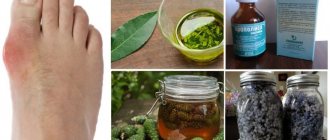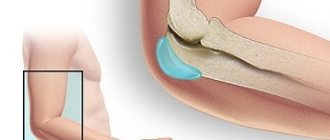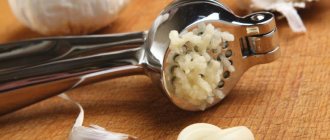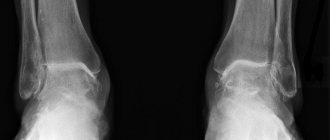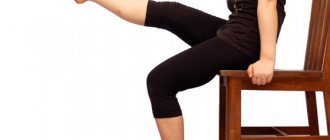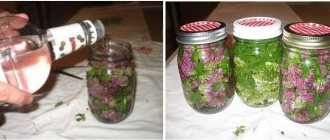- We relieve pain in the heel area in 1-2 sessions
- We use the “gold standard” for heel spur treatment
- We provide an individual approach to each patient
A heel spur (plantar fasciitis, calcific tendinitis of the plantar ligament) is a bone growth in the form of a spike or wedge in the area of the plantar surface of the tubercle of the heel bone. Heel spur belongs to a group of diseases such as enthesopathies - diseases of the attachment of tendons, ligaments, fascia to the bone, in which degenerative and inflammatory changes are observed.
Causes of heel spurs
The main reason for the development of heel spurs is chronic trauma to the plantar aponeurosis as a result of various reasons. Thus, in patients suffering from flat feet, heel spurs are often detected. As a result of the development of a chronic inflammatory process in the plantar fascia, calcium salts are deposited. The main starting processes are:
- excessive stress on the legs
- overweight
- uncomfortable shoes
- frequent microtraumas in this area among athletes
- flat feet
- consequences of heel injuries
Where do plantar warts come from?
HPV enters the body from the outside. Pathogens love moist environments. You can become infected by wearing someone else's shoes, neglecting the rules of hygiene in pedicure salons, baths, saunas or swimming pools. A virus suppressed by the immune system may not manifest itself for years. But in a weakened body, viral particles begin to divide very quickly. The propagation of plantar strains is facilitated by:
- increased sweating of the feet;
- uncomfortable tight shoes;
- microcracks in the skin;
- fungal infections of the feet;
- circulatory disorders due to joint deformation: arthritis, arthrosis, flat feet.
Within the epidermis, the virus first infects the basal layer. Then it provokes the proliferation of keratinized particles, forming characteristic hard plaques on the skin.
The main symptom of this form of HPV is severe pain while walking. The roots reaching the lower layer of the dermis constantly injure the nerve endings. Many patients have to give up their usual shoes and use thick, soft insoles to alleviate the pain.
Symptoms
The main complaint that patients have with a heel spur is a burning pain when placing weight on the heel; a feeling of a “nail” in the heel is the most common symptom of a heel spur. Lameness often develops. A heel spur significantly affects the patient’s quality of life, especially if it occurs on both legs at once. In this case, if both feet hurt, the patient simply cannot move normally; the only option is to walk on his toes. The main danger of a heel spur lies precisely in the severe pain and limitation of the motor activity of patients against this background.
Medicines for plantar warts
The composition of drugs for removing papillomas includes antiviral compounds, immunomodulators or substances that loosen the stratum corneum of the skin. Pathogens that suppress the reproduction include:
- Fluorouracil: 5% cream for topical use, activates protective cells, slows the growth of warts;
- Imiquimod: promotes the production of interferons, prevents further damage to the skin;
- Viferon: gel for external application, has high antiviral activity.
These drugs have virtually no side effects, but at an advanced stage of papillomatosis they are ineffective. To destroy and remove large warts, keratolytics, necrotizing agents, and cryogenic agents are used. All of them require careful handling, as they contain acids, alkalis and other chemically active components. Dermatologist approval is required before use.
Popular remedies for warts:
- Salipod: a patch with salicylic acid, softens the affected layers of the skin, allowing you to remove the wart and get to its root;
- Super celandine: a solution that “burns out” the keratinized layers, promotes necrotization and death of papillomas;
- Cryopharma: a solution in aerosol form, contains a nitrogenous compound that freezes areas of affected tissue.
These medications must be applied pointwise to warts, strictly following the instructions so as not to damage healthy skin. The period of death of warts after their use: from 5 to 20 days. In advanced cases, you need to repeat the procedure. Remains of papillomas must be removed mechanically, and wounds must be treated with iodine solution.
Treatment
Treatment for heel spurs is conservative in most cases. It is worth noting that surgical treatment methods, according to foreign authors, have proven to be low in effectiveness. Drug and physiotherapeutic treatment of heel spurs is aimed at relieving inflammation of the tissues around the heel tubercle and increasing the elasticity of the ligaments. In this case, even a bone growth will not cause pain when walking. Doctors at the Bone Clinic will select an individual treatment program for each patient.
It is worth noting that for a long time, the treatment of such a group of diseases as enthesopathies, namely heel spurs, was quite problematic. With the advent of the modern method of extracorporeal shock wave therapy (ESWT), treatment of spurs has ceased to be a problem! Currently, ESWT is the gold standard for the treatment of enthesopathies throughout the world. It has been proven that ESWT is more effective than surgery, while being safe and painless. Such unique equipment is available only in one medical center in our republic - the Bone Clinic.
What do plantar warts look like?
Plantar warts, or, colloquially, thorns, are benign manifestations of several strains of the human papillomavirus. Unlike their “brothers”, which usually occupy the more delicate skin of the hands, neck or face, these tend to go where the epidermis is rough and subject to constant friction.
They are discovered by accident. The main symptom is a sharp stabbing pain in the foot or between the toes, as if from a pebble or splinter caught inside. Upon examination, raised round keratinized plaques of white or yellowish color with depressions in the center become visible. Sometimes dark spots appear inside - damaged capillary vessels of the dermis. The surface of the skin in the affected areas is usually rough or glossy smooth. There is no characteristic papillary pattern on it. This is the main external difference between papillomas and ordinary corns. Dry calluses always retain their skin pattern.
When pressing on the spine, a sharp pain is felt. The keratinized cells grow deeper, irritating healthy tissue as they move. In advanced cases or when trying to pick off such a “callus,” blood appears. Damage to warts often provokes the development of secondary infections, which leads to suppuration. Such neoplasms do not pose an oncological danger, but cause severe physical discomfort.
The treatment program for this disease at the Bone Clinic may include:
Shock wave therapy
More details
PRP therapy
More details
Acupuncture administration of ozone
More details
Teraquantum therapy
More details
Interference therapy
More details
What to do if a thorn appears on your heel
If a thorn appears on your heel, the first thing to do is seek medical help. Firstly, you will not be able to independently identify the cause of the characteristic pain when walking. Secondly, it is not possible to establish the potential cause of salt deposits in the area of the calcaneus and talus without laboratory tests.
Remember that only a doctor can tell you what to do with a thorn on your heel and how to properly treat this disease.
At the initial visit, the orthopedist examines and palpates the affected area. Diseases such as neuritis, deforming osteoarthritis of the ankle joint, heel spur, plantar fasciitis, cicatricial deformity of the ligamentous and tendon apparatus, osteoporosis, etc. are excluded.
For diagnosis, an x-ray examination is required. In the image, the doctor can see salt deposits in the form of osteophytes or bone calluses. Depending on the nature of the layers, the potential cause of the development of pathology can be determined.
Then a general and biochemical blood test is prescribed. Based on their results, it is possible to identify disorders of uric acid metabolism, rheumatic tissue damage, diabetes mellitus and many other pathologies that lead to the formation of osteophytes and spines on various bones.
In difficult diagnostic cases, CT and MRI examinations may be indicated. The doctor may also prescribe arthroscopy if, in his opinion, the patient will require surgical intervention to restore functionality.
After an accurate diagnosis is made, an individual course of treatment is prescribed. We’ll talk further about how to carry it out correctly and how you can avoid the need for surgery. In the meantime, here are some practical recommendations for those who are currently experiencing heel pain when walking and at rest.
What to do first:
- exclude any physical activity (if pain occurs when walking, this indicates that there is tissue destruction, it is better to provide yourself with peace for now and prevent further pathological process);
- stop using shoes that cause discomfort;
- Consult an orthopedist as soon as possible for a full diagnosis and treatment.
Do not use any remedies at home that are not approved by your doctor. It is especially important to pay close attention to the prospect of taking painkillers. It is clear that any pain interferes with everyday activities and you want to solve all problems with one pill. But it is the use of painkillers that brings patients to the operating table. The longer you mask the pain with pharmacological agents, the more your heel and talus bones will be destroyed.
Onion
Another vegetable with a rich chemical composition. Onions are a storehouse of sulfur-containing substances, carotenoids, vitamins, essential oils, acids, saccharides and flavonoids. All its components have phytoncidal activity.
An onion compress is easy to make. You need to cut the onion head into two equal parts, without removing the peel, and then put it in a 0.5-liter jar or any other container. Then you need to fill it with vinegar - the liquid should cover the vegetable completely. Next, the jar must be tightly closed with a lid and placed in the refrigerator for 12 hours.
What then? It is necessary to thoroughly steam your feet and, after wiping them dry, apply the bulbs to your heels. They should touch the skin with the cut side.
After this, you need to secure the compress with an elastic bandage, wrapping the entire foot in it. Place a plastic bag on top or wrap everything in cling film (to create a steam bath). Then go to bed.
The next morning, you can remove the bag, unwind the bandage and, having removed the onion, throw it away. In the evening, repeat the compress, but only with a new vegetable, of course.
How to Cleanse Rough Skin with Foot Baths
A relaxing foot bath with salt and oils is a complete spa treatment that you can do at home at any time. By following the instructions, you will soften rough skin, relieve fatigue and enjoy foot care.
First you need to fill a container with hot water at a comfortable temperature, about 37-39 degrees. Dissolve the bath mixture in it at the rate of 1 tablespoon for every liter of water. 15-20 minutes are enough to steam the skin. Don't keep your feet in the water for too long, otherwise the water will cool down and you will get the opposite effect.
After steaming, you can start working with a file, grater and pumice. There may be a lot of skin at first, don't let that worry you.
Finish the treatment with a relaxing foot massage. Stretch each foot separately, rubbing it from heel to toes and back. Rub and twist each finger. Press the edges of your foot several times. Apply precise pressure and rub your foot, moving through all areas from the heel to the toes. Massage the heel with circular movements and pinching. At the end, you can stroke it and twist your leg a little in the joint.
After such a massage, local blood circulation in the feet improves, fatigue and swelling go away, and the skin well absorbs all the beneficial substances from the oil or cream. At night, the body undergoes the most active regeneration, so we recommend performing the procedure before bed.
Which foot bath to choose?
The secret of the effectiveness of the baths lies in their natural composition, rich in magnesia and beneficial acids. The product is ideal for relieving fatigue and swelling, reducing inflammation, relieving pain after sports, moisturizing and nourishing the skin, preparing for a pedicure, as well as for people suffering from skin diseases. Epsom offers two foot baths that may interest you:
Foot bath “Foot Pleasure” with mint and lemon essential oil relaxes, relieves swelling and moisturizes the skin of the feet. A cooling bath will soothe discomfort and relieve swelling after sports or high heels, and the invigorating aroma of mint and lemon will instantly lift your spirits.
Epsom salt relaxes muscles, relieves pain and spasms. Salt removes excess fluid, quickly reducing swelling.
Sea salt relieves inflammation, promotes skin regeneration, healing of calluses and small wounds. Baths with sea salt reduce sweating and stop the development of nail fungus.
Lemon and mint essential oil restores tone to the legs, refreshes and relieves fatigue.
Tea tree essential oil has anti-inflammatory and antiseptic properties, improves blood circulation and fights fungus.
Sage essential oil soothes and heals damaged skin.
Macadamia oil nourishes and softens the skin, moisturizes the cuticle and takes care of the delicate skin of the feet.
Epsom Relax foot bath with chamomile and lavender essential oil nourishes the skin, relaxes muscles and relieves nervous tension. A warm evening bath with the aroma of lavender will give your feet lightness and comfort.
Epsom salts soothe muscles and relieve pain and spasms. Salt removes excess fluid, quickly reducing swelling.
Sea salt relieves inflammation, reduces sweating, promotes the healing of small wounds, and effectively fights fungus.
Himalayan salt softens calluses and corns, accelerates skin regeneration, and tones.
Lavender essential oil soothes the skin and nervous system, helps you relax and fall asleep faster.
Tea tree essential oil has anti-inflammatory and antiseptic properties, improves blood circulation and fights fungus.
Chamomile extract relieves irritation and itching, soothes the skin after insect bites.
Macadamia oil nourishes and softens the skin, moisturizes the cuticle and takes care of the delicate skin of the feet.

